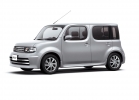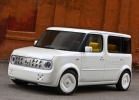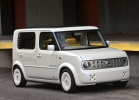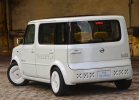Test Drive Nissan Cube since 2008 Minivan
New Generation Review Nissan Cube
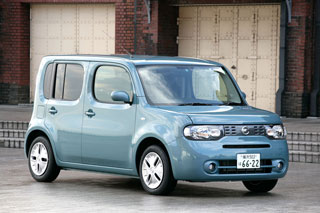 In the footsteps of the revolutionary cube of the second generation
In the footsteps of the revolutionary cube of the second generation For several years now, I am convinced that Japan can be proud of the world in three cars is Toyota Prius, Nissan GT-R and Nissan Cube second generation. Prius is known to the world due to its hybridity, GT-R is famous for its speed characteristics, and Cube revolutionary body design.
However, the planet still could not appreciate the charms of Cube. Whether Nissan doubted the success of an unusual design, whether there were problems with the creation of the left-hand version unfortunately, the second generation cube was not yet destined to see the world outside of Japan.
Few people can argue with the fact that the car should be a temporary dwelling, and the Japanese, like no other, succeeded in creating such cars. As in any developed country, the movement on the streets of large cities in Japan is very slow, and the plugs are long, that is why it becomes of great importance how a person feels inside the car. The inner space of the car is growing, all sorts of ways appear to take themselves in traffic, the displays of entertainment systems increase, navigation systems are improved. And at the same time, the painstaking design goes over the appearance of temporary dwelling.
It seems to me that this tendency originated in the 1980s together with fashion on retro cars, and in our time she reached his peak in the face of Nissan Cube second generation. This car was truly handsome and bold, to the slightest details. The flat dashboard was simply concluded with common sense, and over-comfort seats typified associations with Italian soft furniture. By themselves, these seats were not something revolutionary in the world of the design of the AUTO interimers, but such a degree of home comfort was probably achieved for the first time. And how nice to listen to my favorite music in the player, which does not look tightly. That heights reached Cube in 2002.
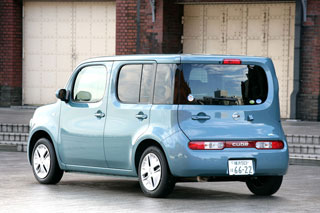 You can conduct an architectural analogy: as an ultra-modern building looks among the buildings in the old style, and Cube has highlighted against the background of the rest of Japanese cars.
You can conduct an architectural analogy: as an ultra-modern building looks among the buildings in the old style, and Cube has highlighted against the background of the rest of Japanese cars. Although, of course, in this regard, Japan, and after a hundred years, do not catch up with Italy, today the new Fiat 500, or Germany with its VW Beetle, regenerated in 1998. After all, if a little change the angle of view, it will become clear that Cube is the brainchild of the country, which is known for bad living conditions and a relatively small tendency to ride cars. In other words, Cube clearly ahead of his era.
Flight of designer thought
And so, in front of us Nissan Cube of the third generation. In a conceptual plan, the car completely did not change the sin to change such beauty! But still there is the results of the continuous evolution of Cube. This is a practically perfect example of a full update model.
The key point here is a focus on the international market. Nissan finally understood how Cube needs in the United States and Europe. Foreign autogurors called the third generation Cube long-awaited car number one, and in the end, the European Nissan branch in the face of French management gave good. Then everything was clear: it was necessary to continue to improve the car and at the same time to internationalize it.
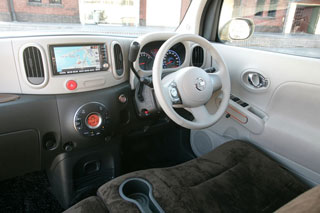 The simplest dimensions: compared to the Japanese model 2002, the renewed body added in length 160 mm, in a width of 25 mm and in a height of 10 mm. As a result, the corresponding dimensions amounted to: 3,890, 1,695 and 1650 mm. The wheelbase lengthened by 100 mm, the length of the front seats increased by 53 mm, and the space between the rear and front seats by 45 mm. Now the passenger is an increase in 190 cm freely both in the front and backseat. That's just a pity that the world will not see more of the Cube Cubic version with three rows of seats.
The simplest dimensions: compared to the Japanese model 2002, the renewed body added in length 160 mm, in a width of 25 mm and in a height of 10 mm. As a result, the corresponding dimensions amounted to: 3,890, 1,695 and 1650 mm. The wheelbase lengthened by 100 mm, the length of the front seats increased by 53 mm, and the space between the rear and front seats by 45 mm. Now the passenger is an increase in 190 cm freely both in the front and backseat. That's just a pity that the world will not see more of the Cube Cubic version with three rows of seats. One of the most memorable impressions is the face of the car, thanks to which he was already dubbed Bulldog in sunglasses. In addition to Bulldog, Robocop and Characters of Picxari cartoons come to mind.
A cube, oddly sounds, continues to round. But this rounding occurs not by type, let's say, Toyota IQ in the case of Cube is increasingly reasonable and exquisite. Cube design becomes the main advantage of Nissan over other Japanese automakers.
Interestingly, the new Cube offers a lot of options for configuration and transformation at the request of the owner. It is also noteworthy that he retained the asymmetrical outlines of the rear braid, but in the left-hand version, this asymmetry repeats the right-handed up to the opposite. Thus, Nissan did a double job by throwing a challenge to themselves. A simpler decision could be a refusal of asymmetry, but the purity of the design execution was priority.
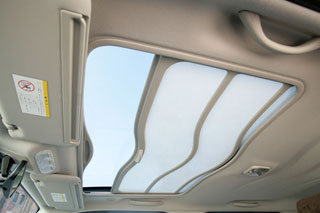 The old and new Cube model differ, of course, not only options for glazing, these differences in the set of parts: rear wings, door mirrors, sunscreen visors, ceiling, sunroof, dashboard, gear shift knob ... It is not left and a hint of a somewhat gloomy former Interior Cube. The outlines of the dashboard, the sheathing of the doors, the seat serves as a new image, to which Nissan applied when creating a new Cube, and this image of a jacuzzi. Here are some more interesting details: the surfaces in the cabin are reminded by water ripples, sunroof (sidie \u200b\u200bJapanese sliding partitions) is made of a translucent material resembling Vasi (Japanese paper), and the door handles are decorated with rubber rings. Take a look at the dashboard: a blue speedometer, and a white tachometer, like earth and moon.
The old and new Cube model differ, of course, not only options for glazing, these differences in the set of parts: rear wings, door mirrors, sunscreen visors, ceiling, sunroof, dashboard, gear shift knob ... It is not left and a hint of a somewhat gloomy former Interior Cube. The outlines of the dashboard, the sheathing of the doors, the seat serves as a new image, to which Nissan applied when creating a new Cube, and this image of a jacuzzi. Here are some more interesting details: the surfaces in the cabin are reminded by water ripples, sunroof (sidie \u200b\u200bJapanese sliding partitions) is made of a translucent material resembling Vasi (Japanese paper), and the door handles are decorated with rubber rings. Take a look at the dashboard: a blue speedometer, and a white tachometer, like earth and moon. Upholstered furniture and car seats in one bottle
The driving quality of the car can not be called magnificent, of course, this is not a sports car, but the cube is not peculiar to the complex of inferiority to other cars. It is just a completely new realization that does not fit into such categories as sports hatchback or sedan.
The platform in this case almost repeats the platform of the past generation. Without large cash costs, the suspension system was slightly improved. The rigidity of the body is slightly elevated, the machine is equipped with more high-precision shock absorbers, the steering wheel became sharper, and riding more quiet and even.
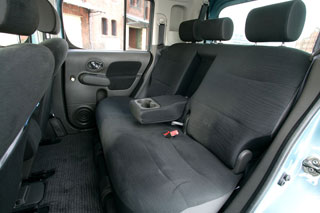 The machine, as before, is equipped with a 1.5-liter 4-cylinder DOHC engine with a capacity of 109 hp with a torque of 15.1 kg-m. And the transmission (variator) was complemented by an adaptive algorithm for selecting gear.
The machine, as before, is equipped with a 1.5-liter 4-cylinder DOHC engine with a capacity of 109 hp with a torque of 15.1 kg-m. And the transmission (variator) was complemented by an adaptive algorithm for selecting gear. Very sweet my heart peculiar lounge salon, and especially seats. As before, they very much resemble soft sofas in which you want to fluff. The pillows thicker are thicker for more than four centimeters, the backs of the front and rear seats have become above 65 and 40 mm, respectively, and the rear seats cushions increased in length by 50 mm. In addition, the new Cube got a tighter dashboard, good salon sound insulation and the newest highly efficient air conditioner.
Three Elements: Project, Technology, Culture
So, retaining his individuality, the Japanese Cube evolved into the World Cube of the third generation, and I would like to note the fact that the car was created by the efforts of the Nissan designers team (in which, by the way, more and more girls appear) with the direct participation of the head of the company Carlos Gon and The main designer of Nissan Siro Nakamura.
In the international design department, Nissan is confident that their work is valued as the most important element in the creation of Cube, and the asymmetrical glazing of the machine should not be perceived as an empty expensive decoration (by the way, when creating a unique body Cube, a Japanese studio used a layout of a certain Vietnamese designer).
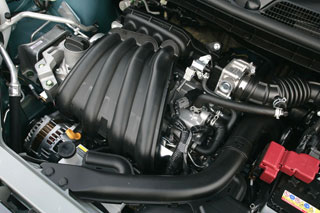 If a little bit into history, the reform of Nissan, started by leadership in 1999, primarily affected the design department, which has since been under the full control of the Nissan manual. In other words, the chief designer of Nakamura now had to discuss the budget of the department directly with Carlos Gon. The inhabitant these words may not say anything, but in fact it is very serious. Take, for example, the Nissan GT-R released last year, this project was able to be implemented due to the fact that the chief engineer Kadzutosi Mizuno received personal instructions from Goh on various issues: from financially to conceptual. But what the Design Manager says Tyoache Simizu: We managed to very competently distribute the budget between different stages of work. Thanks to this, everything turned out.
If a little bit into history, the reform of Nissan, started by leadership in 1999, primarily affected the design department, which has since been under the full control of the Nissan manual. In other words, the chief designer of Nakamura now had to discuss the budget of the department directly with Carlos Gon. The inhabitant these words may not say anything, but in fact it is very serious. Take, for example, the Nissan GT-R released last year, this project was able to be implemented due to the fact that the chief engineer Kadzutosi Mizuno received personal instructions from Goh on various issues: from financially to conceptual. But what the Design Manager says Tyoache Simizu: We managed to very competently distribute the budget between different stages of work. Thanks to this, everything turned out. In order for the product to go into mass production, where hundreds of, thousands of people will work above it, not enough efforts only only a talented designer and a talented engineer. Moreover, if we are talking about an innovative project, with what we are dealing with Nissan Cube. Need an additional force that can combine these two talents, help them avoid conflict, send to the productive direction. And this is not the case of one person, distributing orders, this is a matter of devotion to all employees of the overall idea, culture of the company. Nissan succeeded in the formation of this culture in this and the secret of the brilliant Cube project of the third generation.
Specifications Nissan Cube 15G
Full length: 3 890 mm.
Full width 1 695 mm.
Full height: 1,680 mm.
Wheel base: 2530 mm.
Weight 1 210 kg.
Drive: Front.
Engine: 1.5-liter 4-cylinder DOHC, maximum power 109 hp at 6,000 rpm, the maximum torque is 15.1 kg-m at 4,400 rpm.
Transmission: variator.
Price: 1 911 000 yen ($ 21,400).
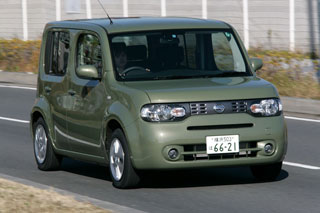
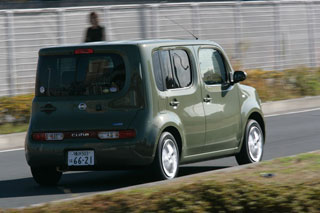
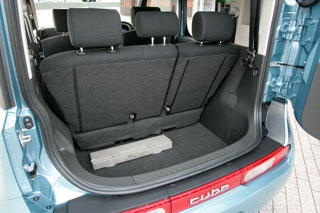
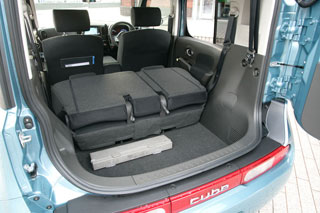
A source: carview.co.jp.
Video Test Drives Nissan Cube since 2008
Video crash tests Nissan Cube since 2008
Crash Test Nissan Cube since 2008
Crash Test: Details83%
Driver and passengers
56%
Pedestrians
64%
Children-passengers
84%
Active security system

